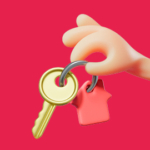A guide to purchasing a buy-to-let property
Investing in a buy-to-let property can be a fantastic way to generate steady income and build sustainable, long-term wealth. But diving into the rental market without the right knowledge can lead to costly mistakes.
Whether you’re a first-time landlord or looking to steadily expand your property portfolio, understanding the essentials of buying a property to rent, as well as the fees and legalities involved, is crucial for any future landlord. In this guide, we’re going to take you through all you need to know about choosing the right property, what mortgage options are available, and how to take those first steps towards becoming a landlord.
What is a buy-to-let property?
Buy-to-let is a type of investment where you buy a property, then act as a landlord and rent it out to tenants. The idea is to use this to generate rental income as well as potentially benefit from the property value increase (capital gains) over time. However, as the landlord, you are still responsible for the property and its tenants, and there are many things you need to understand before diving into this type of investment.
Are buy-to-lets good investments?
While the property landscape has certainly changed over time, buy-to-let is still a great investment for many people – especially with the current rise of the rental market. However, you need to ensure you go in with your eyes open so that you know what you’re getting yourself into, as well as having a dedicated plan.
What is a buy-to-let mortgage?
For those who don’t have the cash in the bank to cover an upfront purchase, there are specific mortgages for buy-to-let properties and landlords. They’re similar to your standard mortgages, where you borrow a certain amount of money from the bank and make repayments each month; however, buy-to-let mortgages typically have different conditions and can be stricter than your regular mortgage. For example, the deposit will be a much larger sum (usually a minimum of 25% of the property value), and the rate you get will be based on your expected monthly rental income.
As a guide, many lenders specify that your rental income needs to be 25% to 45% higher than your mortgage payment. The eligibility terms can differ as well, so it’s important to ensure you find the right mortgage lender for you and thoroughly read through the terms.
Who can get a buy-to-let mortgage?
Depending on the lender’s conditions and assessment, you may be eligible for a buy-to-let mortgage if you fall under some of the following categories.
- You understand the risks involved
- You make £25,000 or more per year (this is a minimum requirement for many lenders)
- You already own a home yourself, with a mortgage
- You have a good credit score and aren’t in debt
- You’re under a particular age. Lenders have upper age limits, which means how old you’ll be when the mortgage ends. This is usually between 70-75 but some lenders will go as high as 90.
How are buy-to-let mortgages different from standard mortgages?
The main difference is how they work out what you can borrow for a buy-to-let mortgage. The lenders will focus more on how much monthly rental income your property could make, and then decide on how much they can lend you.
Another key difference is that you can go for an interest-only product. This means that you’ll only pay back the interest on your mortgage each month, rather than the loan itself. Then, at the end of the mortgage term, you’ll pay the rest of the loan in full. This can be done by using your savings or selling the property.
Buying a buy-to-let property
Now we know a bit more about what buy-to-let is as well as the mortgage options available, let’s discuss everything you need to think about when buying a property of this type. For a successful investment, you need to have good knowledge and consider all the details of purchasing a buy-to-let before becoming a landlord.
Below, we’ve included a checklist of things you should be doing and considering in the buying stage of this process.
Do your market research
You’ll want to research the current rental market before making any big decisions. This is an incredibly important step that will help ensure your investment will be a worthwhile one. The costs, rental income and rental tenancy demand will vary by area, so understanding the local market will help you make a more informed decision if you do buy a property to rent out.
It’ll give you an idea of local demand as well as the type of tenants you might expect and how much rent you will receive monthly. If you want more help with this process, you can read our blogs on what is a good rental yield in the UK? and the best Buy-To-Let areas in the UK for more information.
Find the right buy-to-let mortgage for you
As mentioned above, it is a mortgage option for buy-to-let properties. But every bank and lender will have different terms and conditions, so you’ll need to do thorough research into which one is the right one for you.
You’ll need to ensure that the monthly payments are something you can afford, even if the property is empty (which can sometimes happen when you’re between tenants). During this step, you may also want to consider all of the other payments that come when buying a property, such as valuation and legal fees.
Select your location and begin viewing properties
Once you’ve found a suitable location, you can begin viewing potential properties. If you’ve decided to purchase a property that’s a bit further afield, then you may want to consider hiring a letting agent to help you look after the property and tenants.
Understand tax implications
You must pay tax on your rental income property, and so understanding how much you’ll need to pay or if you’re eligible for any tax reliefs is an important part of buying a buy-to-let property. For this step, you should look into seeking tax advice, as the rules and rates that apply will change according to your and your property’s circumstances.
Understand the responsibilities of being a landlord
Landlords have a duty of care and responsibility to their tenants. Before you invest in a property, it’s important to familiarise yourself with these legal obligations for the safety and security of your property and tenants.
Understand your rental income
After finding a house and doing your research, you’ll need to understand what your rental income will be for the type of property you want to invest in, in that area. You should consider all of the costs of renting out a property, and this can include mortgage payments, bills, maintenance, insurance, and agent fees (if applicable).
Secure your ideal buy-to-let property with SDL Property Auctions
Buying a buy-to-let property can be a rewarding investment, but success depends on careful planning, thorough research, and a clear understanding of your responsibilities as a landlord. From choosing the right location to crunching the numbers and staying compliant with legal requirements, every step matters in securing a profitable return.
If you want to learn more about buy-to-let properties, then you can read through our full guide on buy-to-let properties for more support and guidance. Or, if you’re ready to make the investment, you can browse through our auction catalogues for a wide range of properties to start your search.










